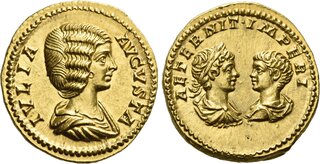| Numismatica Ars Classica > Auction 146 | Auction date: 8 May 2024 |
| Lot number: 2363 Price realized: This lot is for sale in an upcoming auction - Bid on this lot  | Show similar lots on CoinArchives Find similar lots in upcoming auctions on |
| Lot description: Julia Domna, wife of Septimius Severus. Aureus 201, AV 20 mm, 7.14 g. IVLIA – AVGVSTA Draped bust r. Rev. AETERNIT IMPERI Confronted busts of Caracalla laureate, draped and cuirassed facing r. and Geta, bare-headed and draped facing l. C 1 var. (Geta cuirassed). BMC S. Severus 3 var. (Caracalla bare headed). RIC S. Severus 540. Calicó 2653b (this coin). Very rare and possibly the finest specimen known of this intriguing issue. A coin of exceptional quality and beauty with three portraits of superb style perfectly struck and centred on a very large flan. A perfect Fdc Ex Ars Classica III, 1922, Sir Arthur Evans, 94; NFA-Leu 16 May 1984, Garrett, 837; Leu 93, 2005, Perfectionist, 60; Ira & Larry Goldberg 46, 2008, Millennia, 199 and Künker 158, 2009, 658 sales. This coin illustrated in The Roman Aurei by X. E. Calicó. This beautiful Severan dynastic aureus features the empress, Julia Domna, on the obverse while the reverse shows her two sons, Caracalla and Geta. It is very likely the finest known example of this type available, and is the illustrated specimen of the type in the standard reference on Roman aurei by Calicó. The style is exceptional, the surfaces and dies are pristine, and the coin exhibits a strong underlying luster that is simply astounding and beautiful. It will surely become a centerpiece in the collection of the winning bidder. Struck in the years 201-202, this aureus is part of an impressive series of dynastic types, presumably marking the fifth anniversary of the dynasty that Septimius Severus had formed in early 196. It celebrated not only the Severan dynasty, but the marriage of Caracalla to Plautilla, the daughter of the Praetorian Prefect, Plautianus, as well as the heir presumptive's frst consulship. The specific purpose of the issue is clear from the reverse legend, AETERNIT IMPERI ('the eternity of the empire'), which illustrates the continuity of the Roman Empire and equates it with that of the Severan dynasty. There were a variety of Dynastic types struck at this time, combining in varying combinations the busts of the different members of the ruling family. This aureus, depicting the empress, Julia Domna, with her two sons, Caracalla on the left of the reverse in the position of honor, depicted laureate, signifying his status as co-emperor along with his father, Septimius Severus, and his younger brother, Geta, on the right, shown bare-headed to illustrate his lesser position as Caesar, is particularly interesting for the fact that it illustrates a family harmony that was anything but true. In truth, the brothers despised one another, and it was just a matter of tie until their hatred for one another would erupt into violence. Just ten years after this coin was issued, in 212, Caracalla orchestrated the murder of Geta by luring his younger brother to the house of their mother as if for a reconciliation. While there, officers in the employ of Caracalla attacked Geta, murdering him in his mother's arms. Accordig to Cassius Dio, Julia Domna was not even allowed to mourn or weep for her son, instead being forced to show joy and laugh as if his murder in her very arms had been a great stroke of luck. Estimate: 80000 CHF |  |



